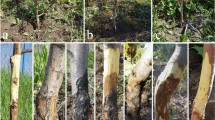Abstract
DURING March–April in 1958 and 1959 a peculiar malformation of flowers (Fig. 1) of blue panic (Panicum antidotale Retz.) was observed at the Institute of Agriculture, Anand. Individual flowers were malformed into false grains similar to smut sori (Fig. 2). When few flowers in an ear-head are infected and malformed, the disease is difficult to be noticed in the field (Fig. 1b). However, when the whole inflorescence is involved, it becomes quite prominent (Fig. 1c). The disease is quite prevalent in the vicinity of Anand. Malformation of panicles in mango1 (Mangifera indica L.) more or less similar to above has been described. However, in case of mango malformation, invariably, whole inflorescence is involved and no fertile flowers are ever borne on such panicles1 and gives the appearance of witch's broom2.
This is a preview of subscription content, access via your institution
Access options
Subscribe to this journal
Receive 51 print issues and online access
$199.00 per year
only $3.90 per issue
Buy this article
- Purchase on Springer Link
- Instant access to full article PDF
Prices may be subject to local taxes which are calculated during checkout
Similar content being viewed by others
References
Narasimhan, M. J., Curr. Sci., 23, 297 (1954).
Mundkur, B. B., ‘Fungi and Plant Diseases’, 33 (Macmillan and Co., Ltd., London, 1949).
Author information
Authors and Affiliations
Rights and permissions
About this article
Cite this article
DESAI, M., THIRUMALACHAR, M. Floral Malformation in Panicum antidotale caused by a Species of Eriophyses . Nature 184, 1586–1587 (1959). https://doi.org/10.1038/1841586a0
Issue Date:
DOI: https://doi.org/10.1038/1841586a0
Comments
By submitting a comment you agree to abide by our Terms and Community Guidelines. If you find something abusive or that does not comply with our terms or guidelines please flag it as inappropriate.



